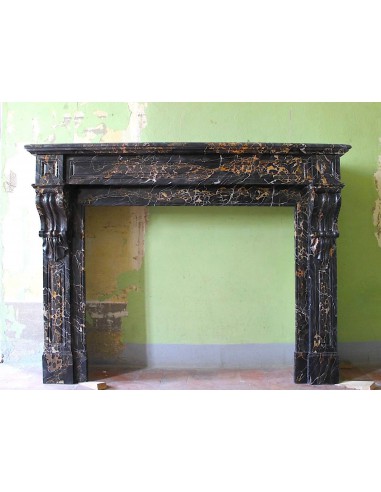MY SON ENRICO (VERY GOOD AT EVERYTHING BUT PERHAPS TOO MODEST), IN THE TITLING OF THIS CARD HAD WRITTEN THAT THE PORTORO MARBLE WITH WHICH THIS VERY RARE SPECIMEN OF LUIGI FILIPPO “PALMETTES” WAS CARVED WAS TO BE CONSIDERED “PRECIOUS”!!!
SO I HAD TO, ALBEIT RELUCTANTLY, CORRECT ENRICO AND POINT OUT THAT THE PORTORO MARBLE IS NOT AT ALL DEFINABLE AS PRECIOUS, BUT RATHER MUST BE DEFINED ONLY FOR WHAT IT IS, NAMELY, AS “THE MOST PRECIOUS MARBLE ON THE GLOBE.”
PRECIOUS ARE A THOUSAND MARBLES IN THE WORLD, BUT THE MOST PRECIOUS IS ONLY ONE.
Yes, the design of this specimen is the more classic “Palmettes” model (this name comes from the two palm leaves decorating the protruding shelves), but... have you noticed how in its slabs, in all their surfaces, elegant squares have been carved ?
Elegant and well done, since the sculptor's burin did not perform a simple and single “gouge” (or “groove,” if you prefer), but as many as three operations in depth, three levels for each line he wanted to mark ... maybe you will not believe it (but you will have a friend, I do not say sculptor, even just . . stonemason, to ask if I am telling you fibs..) maybe you won't believe it, I was saying, but I can guarantee you that it took more time to make those particular squares than to build the whole structure of the fireplace, except for the creation of the Palm Leaves.
Sometimes you read that “details matter,” well, this is an example of how true that statement is...
It is not that I have done all this romancing in order to then raise the price (which is, essentially very high only because of the “fabric” with which this specimen was carved, the now mythical PORTORO MARBLE, which has been sold out and in the dreams and desires of the wealthiest women in the world for half a century), I have instead written this specific note to make you understand how much work went into making this marble artifact, how much artistic effort, how much time and sweat
OPTIMUM CONSERVATION, PROVENANCE CÔTE D’AZURE, PERIOD 1840-60, DELIGHTFUL MEASURINE.
MARGIN NOTES: TECHNICAL-HISTORICAL FACT SHEET RELATED TO PORTORO MARBLE:
Portoro marble, quarried on the tiny island of Palmaria (located in the Gulf of La Spezia, Italy), formerly called “mischio giallo e nero,” then “marmo di Portovenere,” assumed its present name from the Italian translation 'Porta d'oro', from the French 'Porte d'Or."
Why should a very Italian marble bear a name derived from French?
Because the French (led by the architects of the Parisian Ateliers des Arts) were strenuous worshippers of this fascinating marble and traded in it all over the world, in the face of the Italians who (go look at the breakwater boulders of several countries overlooking the Gulf of La Spezia) instead of selling it at prices appropriate to its lineage (i.e., very high), used this marble, precisely, to make breakwaters. But can anyone be more of a jerk than that!
The English-speaking peoples, on the other hand, also very fond of this fantastic marble, knew it from ancient times by the name “Black and gold.”
UP TO HERE IS THE WORK OF MY OWN HAND WHILE THE LINES BELOW (BUT DON'T TELL PEOPLE) WERE WRITTEN BY A GENTLEMAN (IT WILL BE A GERMAN...THERE HAS A STRANGE NAME, BRISTLING WITH W AND K, IT'S CALLED WIKIPEDIA)
Portoro is one of the most distinctive and beautiful polychrome veined marbles, from the geological side it is a Rhaetic limestone, belonging to the Mesozoic or Secondary era.
It can be considered a breccia or brecciated marble.
It has an absolute black background and pyritic and ochraceous lemony veining and staining of a beautiful golden yellow color.
In the gradually lesser qualities and varieties the absolute black lightens more and more, until it takes on a pale grayish bardiglioceous hue.
The yellow-gold parts (veins and spots) gradually yellow to a russet hue and less contrast of the whole.
On the technical side it is firm, tight and compact material, its prevailing pigmentation being of a carbonaceous nature not recent on the geological side, as in black marbles.
The very first blocks that came out of the quarries on Palmaria Island and from the chisel of sculptors from Lunigiana were used for the church of S. Maria alla Spezia and for the palace of the marquises of Castagnola.
In the early 19th century, Portoro marble began to be exported to many countries in Europe and later to America.
One example for all: Paramount's great projection room is all lined with it!!!
A quarry on Palmaria was named Carlo Alberto because of the visit that the then King of Sardinia (an admirer and consumer of this fascinating marble) made to the island on October 2, 1838, to select slabs of marble later laid at the Palace of Venaria.
The last quarry to be closed, following an ordinance issued in 1982 by the city council, was the Caletta quarry, located in front of the Tino, where remnants of equipment and remnants of marble blocks can still be found.








































































